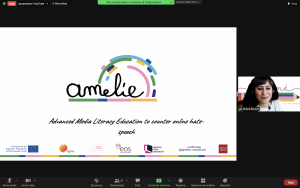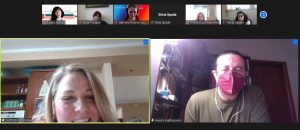On 24th March, ALL DIGITAL hosted a webinar on the topic “Innovative approached to enhancing media literacy of students and teachers”. The event took place during the second week of this year’s ALL DIGITAL Weeks. It put the focus on two Erasmus+ projects for students and teachers. In AMeLiE, teachers work with their students on online hate speech through the principles of non-hostile communication, so students can learn how to analyse online messages and how to choose and promote alternative narratives in their everyday online communication. On the other hand, CrAL uses the language of cinema and moving images, with the same ultimate aim: to teach students (and teachers) to reflect on how images represent the reality around them, and how they can be used to convey a certain message or point of view.
Peter Palvolgyi, ALL DIGITAL CEO, opended the webinar with an introduction to the ALL DIGITAL Weeks campaign. Gabriela Ruseva, ALL DIGITAL Project Officer presented the event’s agenda and speakers.


The event featured some of the teachers taking part in the project. They shared their experience with the methodology and how they were able to deepen the topic of online hate speech with their students.
Katerina Lazoudi, Teacher at 2nd Lykeum of Xanthi in Greece, stating that: “Our goal was to take on the concept of empathy, sympathy, through free dialogue, and group play. The students were concerned about the violence that exists in such a strong form in society and the anger that leads people to verbal (and not only) violence. They realized that they could find themselves in position to be bullied or intimidated by other classmates, if they do not have empathy”. Students realized the importance of being able to put themselves in other’s shoes thanks to the programme. Anestis Exaftopoulos also teacher, and deputy director, at 2nd Lykeum of Xanth in Greece, talked about what he was working on with his students: “We are preparing our own educational material based on the AMeLiE lesson plans. We are going to test it and then we will upload it on the AMeLiE platform. We used the lesson plans to make digital lesson with the Learning Management System (LMS) Moodle, so that we can have students enrol in this lesson, and so that they can cooperate and with each other”.

Another testimony of the work carried out in the classroom was brought by Corina Maliara, teacher of the experimental school of Isobel University Thessaloniki, who said: “We watched the video as an introduction, then we moved on to the PowerPoint presentation on the platform, related to the manifesto. It explains and exemplifies the principles of the manifesto. Lastly, the students formed groups, and worked on creating a product to promote one of the Manifesto’s principles”.

The last teacher to speak was Anca Tulugea, who confessed that at the beginning she was a little sceptical about her students’ reactions. Despite of what she expected, the students collaborated to create posters and videos about the use of words online that can hurt others. She showed some of the posters created by the students.

Gabriela Ruseva described the other best practice in focus of the webinar – the creative audiovisual labs (CrAL project). The main product of the project is the innovative educational methodology on how to set up creative audiovisual labs in schools. In these It is a project in which teachers and trainers from Croatia, Greece, Italy, Lithuania, and Spain will be trained in the methodology, which they will then test in their classrooms with high school students. Another Manifesto, with 10 principles on how to foster creativity, has been drawn from the methodology. In the words of Annio Gioacchino Stasi, Italian film director and educator, “the methodology is trying to show the link between images and words. Working with images implies intellectual and above all human honesty. We see the effects of the images that confuse, lie, destroy, and unfortunately, at times convince”. The methodology proposed aims to create an “Audiovisual Literacy” programme that is not a training in marketing but fosters critical and out-of-the box thinking.


